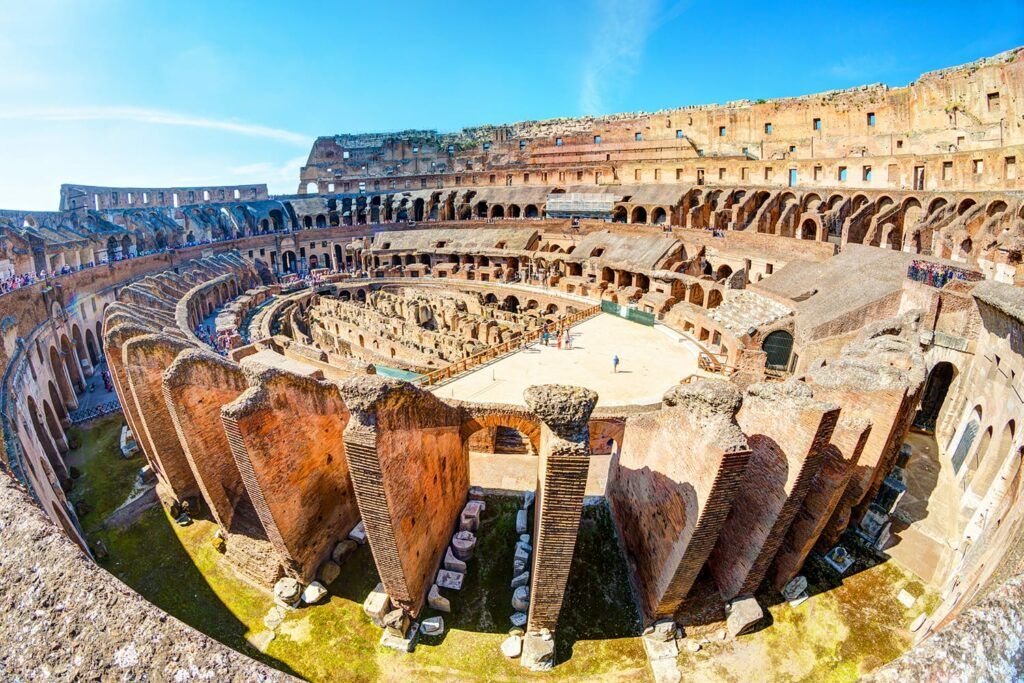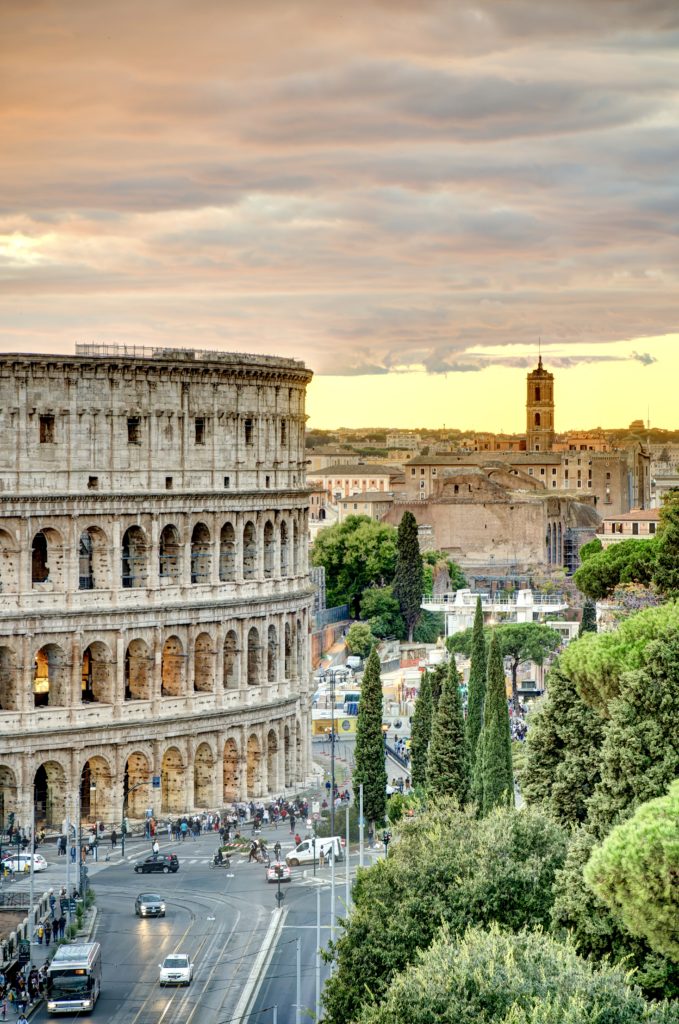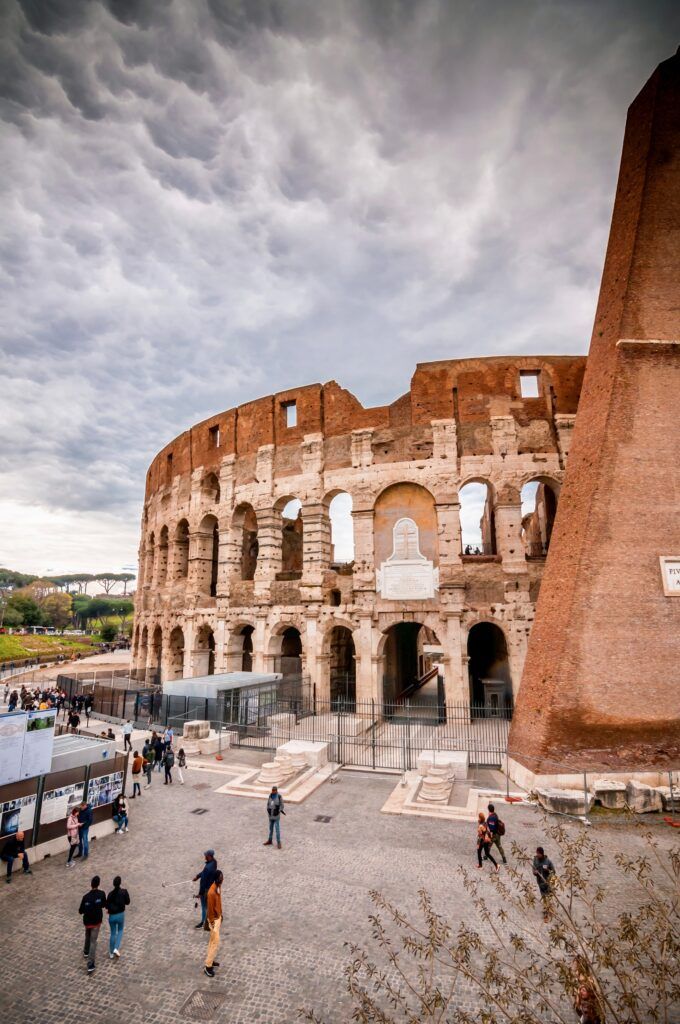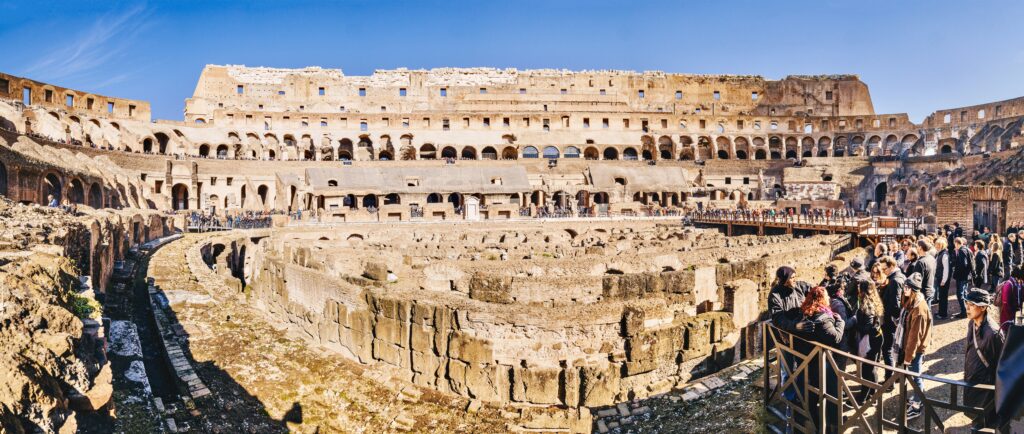Planning a trip to Rome? Don’t miss the Colosseum, an iconic symbol of the ancient Roman Empire!
This monumental amphitheater, standing for nearly 2,000 years, is a marvel of ancient architecture and the largest of its kind in the world.
Despite centuries of wear and tear, the Colosseum remains remarkably well-preserved, allowing us a glimpse into Rome’s intriguing past and its architectural prowess.
This structure is not just a monument.
It’s a window into ancient Roman life, where gladiatorial battles and wild animal fights were a popular form of entertainment and a testament to Rome’s fascination with spectacle and sport.
As you explore the Colosseum, you’ll be transported back in time, surrounded by stories of gladiators, chariots, and exotic animals that once battled in this grand arena.
Interestingly, “Colosseum” is actually a nickname. The amphitheater’s original name is the Flavian Amphitheater, named after the Flavian dynasty of emperors who constructed it.

To help you have the best visit, I’ve put together a guide for visiting the Colosseum.
It’s an incredibly popular spot, so it’s important to pre-book tickets and reservations. Don’t worry, I’ve got you covered in the tips section below with all the details on the tickets, best tours, etc.
Here’s a snapshot glance of what you can see on a visit:
- exterior facade
- seating areas
- arena floor
- trap doors
- basement or hypogeum
- third ring or attic
- statues and plaques

Guide To The Colosseum: What To See
1. Exterior Facade
With its unique elliptical shape, the Colosseum was ingeniously designed to provide a great view from every seat. It spans 188 meters at its longest and 155 meters at its shortest.
The structure features three levels of arches, each adorned with columns that evolve in style from Doric at the bottom to Ionic and then Corinthian as they rise to the top, known as the “attic” level.
Above this was the Vellurium, a cleverly designed retractable awning that protected spectators from rain or harsh sun.

While there’s been debate over whether the Colosseum once had a dome, what it did have was an innovative system of horizontal sails for weather protection.
On the ground floor, the Colosseum had 80 numbered arches, simplifying access for the thousands of spectators.
Notably, four special archways were reserved for the most prestigious attendees like the emperor, senators, and performers, adding a touch of exclusivity to this ancient entertainment hub.
2. Seating Areas
The Colosseum could likely seat as many as 80,000 people.
Roman chroniclers claim they could fill and empty the Colosseum in 20 minutes. Once inside, spectators would enter a passageway known as the Vomitorium.
The word Vomitorium isn’t as gross as it sounds. It connotes moving or expelling. After passing through the Vomitorium, spectators would head to their seats.
The seats were essentially a series of bleacher seats running the entire circumference of the ellipse. Row upon row of seats were built on an incline.
There were three distinct sections: 20 rows at the bottom, 16 in the center, and 16 on the top. Where you sat was based on your social status.
The ringside seats were marble. These were the front row Imperial seats.
They were reserved for emperors, senators, the vestal virgins, and other celebrities. The next level up was for Rome’s well-to-do middle class.
The highest level was for the plebians, the free Roman citizens. At the very top, slaves and women sat on wooden nose bleed seats or were standing room only.
3. The Arena Floor
When you step into the Colosseum, the first thing you’ll notice is the arena floor, often called the “stage.” This is where the ancient Roman spectacles unfolded.
One notable entry point to the arena is the ominously named Gate of Death, through which the bodies of fallen gladiators were carried out.
The arena itself, with its oval shape, is encircled by a brick wall.
In the past, this wall was topped with elephant tusks, a clever design to prevent animals from climbing out during the games. It was in this central area that the famous gladiatorial games and other spectacles took place.
Interestingly, the arena floor was made of wood and covered in sand. The sand had a practical yet grim purpose: it helped to soak up the blood from the violent battles that were a hallmark of these ancient entertainments.
There’s a bit of reconstructed floor to give you a sense of what it looked like.
There’s also a reconstructed trap door, which was one of 36, from which the animals below were launched onto the stage as if by magic.
You can’t help but feel small and insignificant standing on the edge of the arena floor. Before you are the massive ruins of the ancient world’s most impressive amphitheater.
4. The Basement, or Hypogeum, of the Colosseum
The hypogeum of the Colosseum was essentially its underground basement. It played a crucial role as the backstage area for the spectacles held above.
This space, now resembling a labyrinthine pit, was once bustling with activity. It consisted of an intricate network of tunnels, dressing rooms, animal cages, and holding areas, all hidden beneath the arena floor.
In this underground maze, slaves, prisoners, animals, and gladiators awaited their turn to enter the arena for their “performances.”
The hypogeum was equipped with sophisticated machines like ramps, trap doors, cranes, and lifts.
These devices were used to transport props and animals to the arena floor, often surprising performers with unexpected entrances of wild beasts.
Today, with the arena floor no longer present, most of the hypogeum is exposed, revealing grassy areas where once there were tunnels and cages.
However, the underground structure around the outer rim of the arena is relatively well-preserved, and this is the part you can explore on a tour.
You’ll stroll down the central corridor once used by gladiators, treading the same path these ancient warriors once did.
Along the way, you can spot the remnants of canals that were ingeniously designed for staging mock sea battles, a time when the Colosseum was temporarily flooded for these grand naval reenactments.
In the hypogeum, some parts have been reconstructed to give visitors a better sense of how it functioned in ancient times.
This includes replicas of the lifts and elevator shafts that were used to transport animals and gladiators up to the arena floor. These reconstructions help you visualize the bustling underground activity that was integral to the spectacles above.
As you wander through the hypogeum, you’ll notice that it’s quite dim. This gives you a sense of how dark it was when the arena floor was in place, blocking most of the light from reaching this lower level.
The hypogeum wasn’t a pleasant place in ancient times. It was dark, probably quite smelly, and had very little air circulation, far from the glamour of the arena above.
Interestingly, this underground area was buried under 40 feet of earth and forgotten until the 19th century. Early attempts to excavate it in 1813 and 1874 were unsuccessful due to flooding.
It wasn’t until Benito Mussolini’s era, in his effort to revive the glory of classical Rome, that the hypogeum was finally excavated and cleared, revealing the fascinating subterranean world we see today.
5. The Third Ring or the “Attic”
The final stop on a Colosseum tour is the nosebleed seats.
After passing through a gated area on the second level of the Colosseum, you arrive at the Third Ring located at the top of the amphitheater.
It’s the highest part of this UNESCO site. This upper level provides a wide view of the Colosseum and the ruins in the Forum and Palatine Hill.
This is also one of the few spots where you can still see pieces of the original outer walls of the Colosseum. The rest were taken and sold after the fall of Rome.
Tips For Visiting The Colosseum
1. How To Book A Ticket For the Colosseum
Colosseum tickets sell out far in advance. So you should make your reservation as soon as you know your exact visit date.
Tickets are released on a schedule throughout the year. You can see the release schedule in the right hand column of this page.
The cheapest way to get a ticket is to book directly with the Colosseum. A standard ticket is € 16. A ticket to explore the underground is € 9. You can do this online here.
There’s a € 2 online booking fee per ticket. But it’s worth it to secure your preferred time and avoid the long ticket lines.
If you are using the Roma Pass, which includes entry to the Colosseum, you just have to pay the € 2 fee to reserve your time slot online.
If you are having trouble getting a ticket, check the Tiqets website or GetYour Guide for availability.
There are two main lines at the Colosseum for individuals – one for those with a booked timeslot and a ticket, and one for those who want to buy a ticket. Be sure to get in the right line.
2. Colosseum Tours
Alternatively, you can book a curated tour with a private tour company in Rome, which is what I’ve done before. You’ll skip the line and get a knowledgable tour guide to regale you with stories.
You can book a guided tour of just the Colosseum or a guided tour that also includes the underground gladiator area.
I prefer the underground option. It gives you a chance to understand the behind-the-scenes mechanics of ancient Roman entertainment.
Often, Colosseum tours include the Roman Forum and Palatine Hill. You can book a trifecta ticket for all three attractions.
You can also take a guided tour or a private tour of these sites.
3. Practical Information For The Colosseum
Address: Colosseum is Piazza del Colosseo, 1, 00184 Comune di Roma RM
Hours: In high season, the Colosseum is open daily from 8:30 am to 7:15 pm.
Metro: Colosseo (Line B). It’s also a 20 minute walk from central Rome near the Piazza Navona.
Security: Whether you’re on a guided Colosseum tour or have pre-purchased your tickets, you’ll still need to queue for the security check before entering the site.

The wait time for the ticket line can vary, typically ranging from 10-30 minutes, contingent on factors like the time of day and the season.
Guided tours have a special priority entrance. So if you are on one, you will get through security more quickly than if you just have a ticket.
I hope you’ve enjoyed my guide to the Colosseum in Rome. You may enjoy these other Rome travel guides and resources:
- 8 ways to spend 1 day in Rome
- 3 day itinerary for Rome
- 5 day itinerary for Rome
- Hidden gems in Rome
- Best museums in Rome
- Archaeological sites in Rome
- Guide to the Borghese Gallery
- Guide to Palatine Hill
- Guide to the Roman Forum
- Walking tour of central Rome
If you’d like to visit the Colosseum in Rome, pin it for later.

